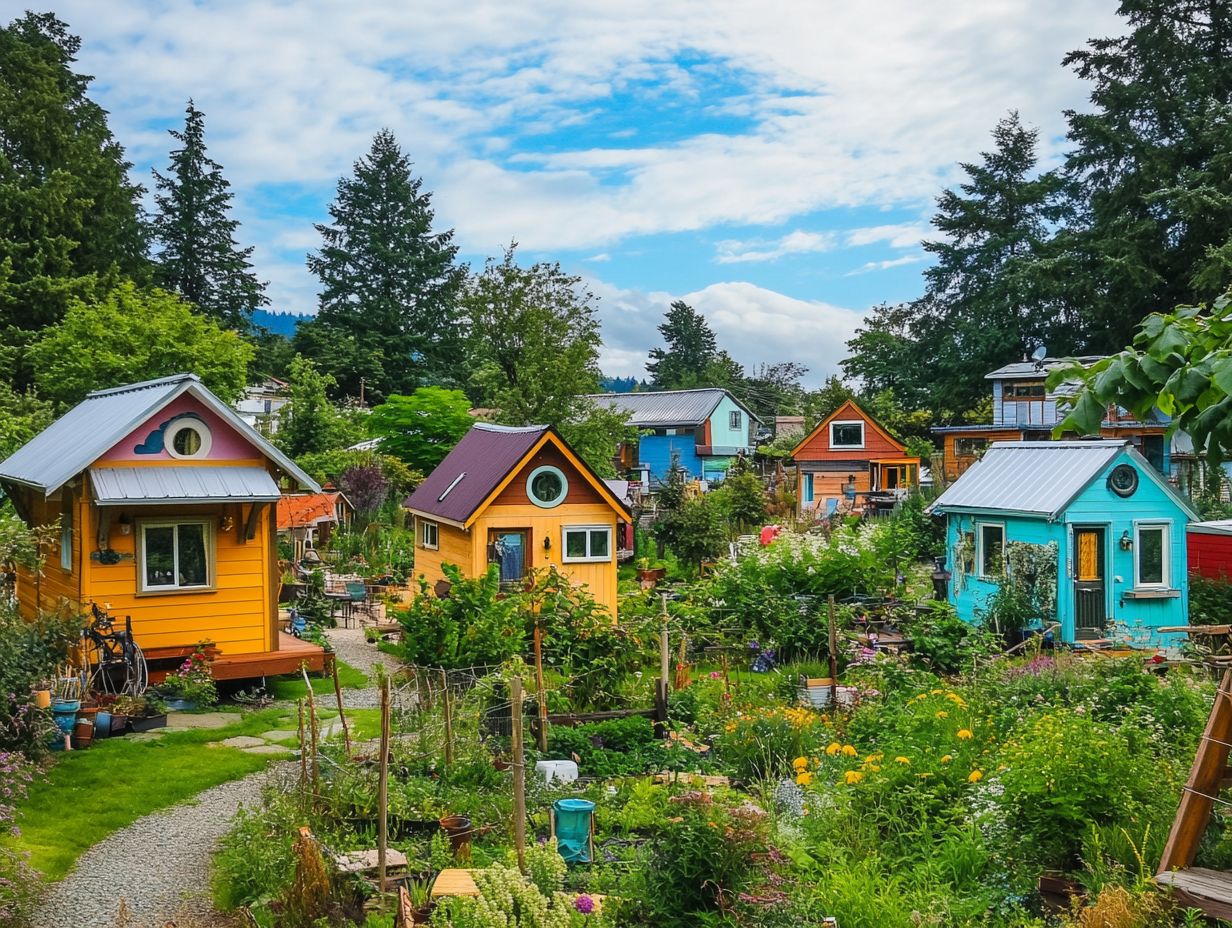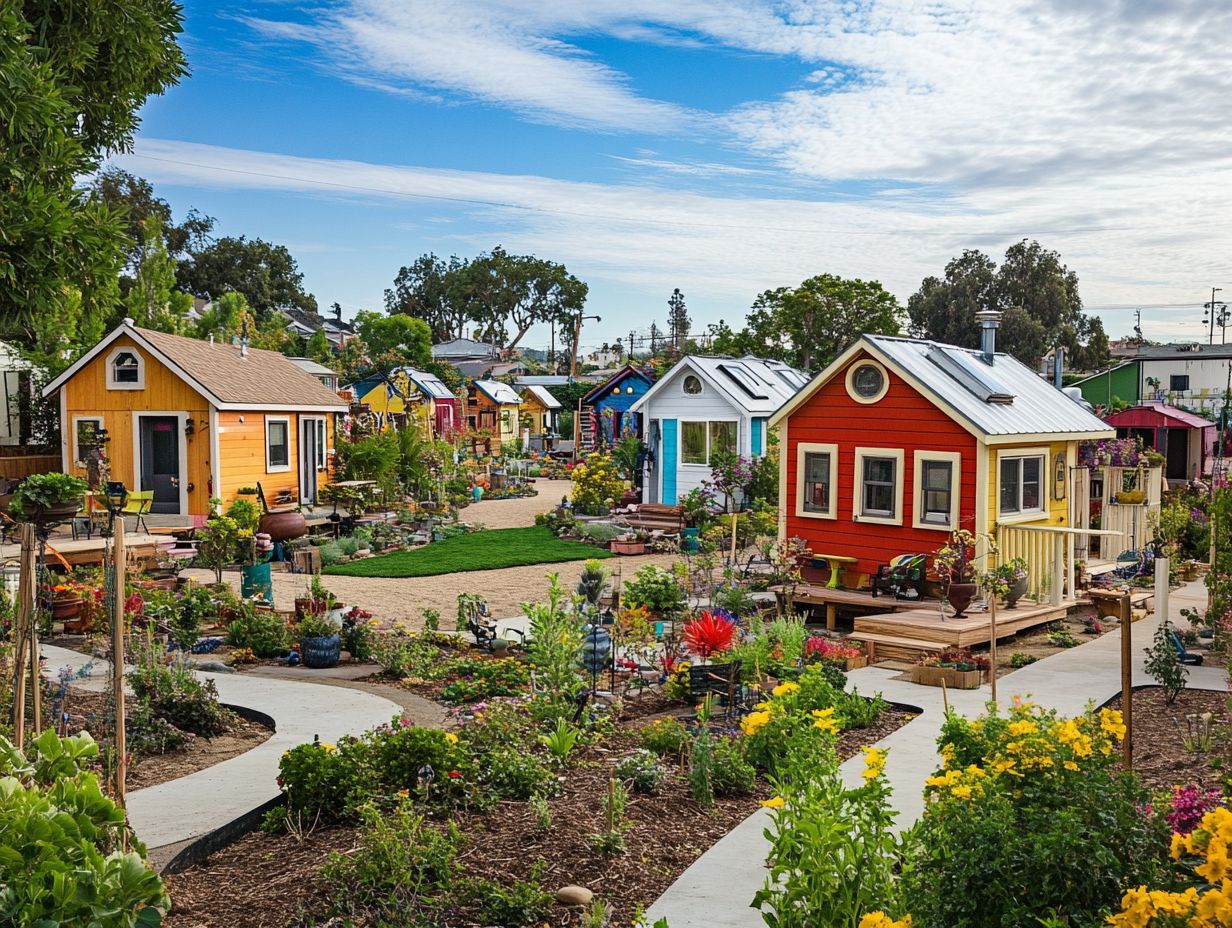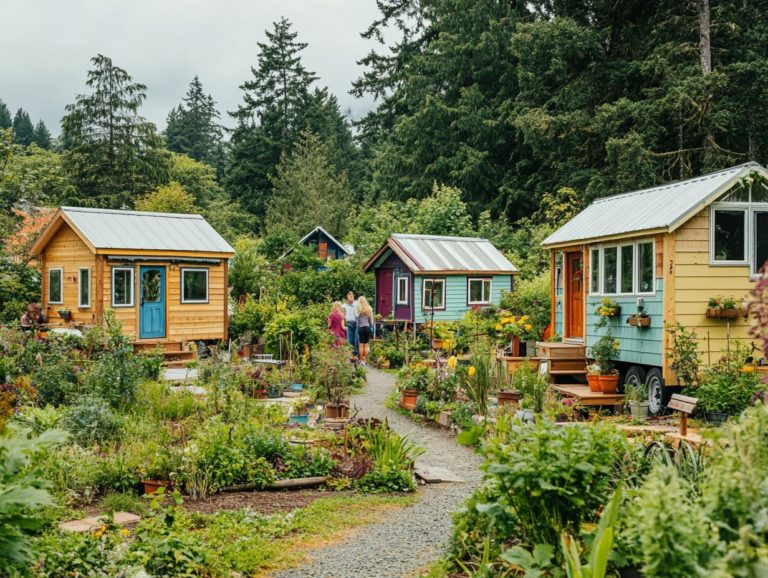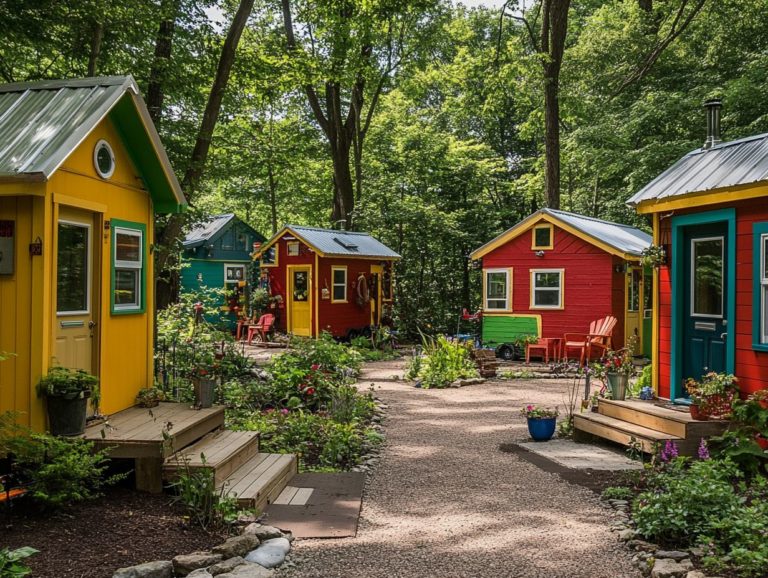Understanding the Dynamics of Tiny House Communities
Tiny house communities are revolutionizing your perspective on living spaces, championing simplicity and sustainability. Join the movement today!
These distinctive neighborhoods combine cozy, efficient homes with a robust sense of community.
In this overview, you’ll discover what truly defines these communities, the myriad benefits they provide, and the challenges that residents might encounter.
Explore how you can join or even create your own tiny house community, along with inspiring examples from around the globe.
Contents [hide]
Key Takeaways:

- Tiny house communities offer a unique and affordable living experience, with a strong sense of community and a smaller environmental footprint.
- Joining or creating a tiny house community requires careful planning and consideration, as legal and zoning issues and community dynamics can present challenges.
- Successful tiny house communities can be found all over the world, with inspiring real-life stories and case studies showcasing their benefits and positive impact.
What are Tiny House Communities?
Tiny house communities represent a revolutionary approach to living, crafted to embody minimalism, sustainability, and a vibrant sense of community.
Nestled in charming locations like Spur, Texas or the Bluegrass Meadows Micro Village, these unique spaces embrace the trend of living in smaller homes, offering you an affordable housing option that prioritizes shared amenities like community gardens and co-working areas.
By cultivating communities focused on environmental sustainability that encourage connections among neighbors, you’ll find yourself enjoying a more enriching and environmentally conscious lifestyle.
Benefits of Living in a Tiny House Community
Living in a tiny house community presents a wealth of advantages, from affordability to environmental sustainability, along with a profound sense of belonging.
You ll find that residents of tiny homes embrace the flexibility and freedom that come with minimalist living not only alleviating financial pressures but also significantly enhancing their overall quality of life.
The communal nature of these neighborhoods cultivates strong bonds among residents, creating opportunities for shared resources and support systems that truly enrich the living experience.
Advantages for Residents
Residents of tiny house communities find themselves enjoying a range of distinct advantages, including shared amenities that elevate their living experience and cultivate a vibrant community spirit.
Imagine communal kitchens and co-working spaces that foster collaboration! These neighborhoods are designed with remote work in mind, catering to diverse lifestyles even those who cherish pet-friendly policies.
Residents also enjoy beautifully landscaped gardens, inviting communal fire pits, and outdoor gathering spaces, all thoughtfully crafted to encourage social interaction and camaraderie.
Picture regular potlucks or movie nights turning casual acquaintances into lasting friendships. These amenities not only help reduce individual expenses but also nurture a sense of belonging, providing a supportive environment where residents can exchange tips, resources, and experiences.
This focus on togetherness proves especially beneficial for individuals or families striving for a more sustainable lifestyle. By participating in collective efforts like gardening or recycling, you can amplify your positive impact on the environment while simultaneously enhancing your quality of life.
Positive Impact on the Environment

The positive impact of tiny house communities on the environment is nothing short of remarkable. These communities embody sustainable living principles that significantly reduce carbon footprints and promote eco-friendly practices. By embracing the tiny house movement, you find yourself in eco-villages where residents take on flexible living solutions that prioritize conservation and efficient resource use.
In these communities, you ll often discover renewable energy sources like solar panels and wind turbines, enabling you to harness nature s power while cutting down on fossil fuel dependency.
By prioritizing shared resources such as communal gardens and tools you foster a sense of camaraderie and collective responsibility toward your surroundings.
Water conservation techniques, including rainwater harvesting and reusing water from sinks and showers for other purposes, further enhance your eco-friendly lifestyle. Plus, the compact design of tiny homes naturally encourages a minimalist approach, allowing you to reduce waste and consume more mindfully.
Together, these principles create a healthier planet and show how tiny house living can change the world!
Challenges of Tiny House Communities
Tiny house communities face urgent challenges that threaten their growth and sustainability, particularly legal and zoning issues that differ from one location to another.
Many areas have specific regulations governing tiny homes, which can obstruct the formation of these communities. Homeowners associations can play a pivotal role; their policies can either support or complicate these community interactions, depending on how they choose to operate. For those interested in this lifestyle, understanding the tiny house movement is essential.
Legal and Zoning Issues
Legal and zoning issues present substantial hurdles for tiny homes and their communities, often hindering the implementation of affordable housing solutions that align with the tiny house movement. Zoning regulations can differ dramatically from one area to another, affecting your ability to establish tiny neighborhoods and cultivate a sense of community among those who aspire to embrace a minimalist lifestyle.
These regulations often impose minimum square footage requirements, limiting the types of structures you can build. In some regions, there may be outright bans on homes smaller than 1,000 square feet, effectively excluding many popular tiny house designs.
The classification of tiny homes as either residences or recreational vehicles can significantly influence the rules surrounding utilities, parking, and applicable building codes. This complex rules can feel overwhelming, with aspiring tiny home dwellers navigating a landscape filled with inconsistencies.
However, success stories from communities that have effectively traversed these regulations serve as a beacon of hope. They demonstrate that proactive local advocacy can pave the way for more inclusive policies, proving that with determination, the dream of affordable housing through tiny homes can indeed become a reality.
Community Dynamics and Conflict Resolution
Community dynamics within tiny house communities can be quite intricate. Shared amenities and pet-friendly policies create opportunities for collaboration but can also spark conflicts among residents.
To maintain harmony and ensure that you’ll love every moment of your tiny living adventure, effective conflict resolution strategies are essential for fostering a supportive community environment.
Navigating these dynamics often requires clear communication methods. Close quarters can amplify misunderstandings and highlight differing lifestyles. Holding regular community meetings can encourage open dialogue, allowing you to express concerns and participate in decision-making. Additionally, understanding what tiny house community benefits can enhance your living experience.
Establishing clear guidelines regarding shared spaces and individual responsibilities helps prevent disputes from escalating. By emphasizing empathy, or understanding others’ feelings, and active listening, you cultivate a culture of collaboration where diverse perspectives are genuinely valued.
Prioritizing constructive communication and community engagement can resolve conflicts and strengthen relationships, creating a more enriching living experience for everyone involved.
How to Join or Create a Tiny House Community

Joining or creating a tiny house community presents an exhilarating opportunity for those in search of affordable housing and a lifestyle characterized by flexibility and freedom.
Numerous resources await your exploration as you consider becoming part of this burgeoning movement. From engaging online forums and vibrant social media groups to informative workshops and local meetups, you ll find many exciting ways to connect and build community!
Steps and Resources
To successfully join or create a tiny house community, explore various resources and networking opportunities within the tiny house movement. Workshops, online platforms, and local meetups offer essential information and connections.
It’s also vital to conduct thorough research on the tiny house communities near you. Each community may have unique features and regulations that cater to different lifestyles, so knowing your options, including unique tiny house communities around the world, is key.
Building relationships with fellow tiny house enthusiasts through online forums or social media groups greatly enhances your understanding of shared experiences. Attending workshops equips you with valuable knowledge and fosters a sense of belonging as you connect with others over common goals of simplicity, sustainability, and cooperation.
This ultimately nurtures a vibrant community atmosphere.
Inspiring Tiny House Communities You Should Know About
Across the globe, numerous thriving tiny house communities have emerged, showcasing the myriad possibilities and benefits of tiny living.
From Tiny Tranquility in Oregon to Bluegrass Tiny Ridge in Kentucky, these communities provide valuable insights through compelling real-life stories and case studies. You’ll find inspiration in how they cultivate a sense of belonging while embracing a simpler, more eco-conscious lifestyle.
Join the tiny house movement today and transform your life!
Real-Life Stories and Case Studies
Discover how tiny house communities are changing lives! Real-life stories and case studies vividly illustrate the profound impact of community spirit and the benefits of affordable housing solutions. These exciting stories reveal the unique journeys of residents, showcasing how tiny homes have transformed their lives and fostered deep connections within their neighborhoods.
You’ll find tales of individuals rebuilding their lives after personal crises, creating vibrant communities filled with collaboration and support. These stories highlight how embracing a minimalist lifestyle allows people to prioritize relationships over material possessions. Many residents share their experiences of reduced financial stress, which opens the door to exploring hobbies, volunteering, and engaging with neighbors in places like the best tiny house communities.
Picture a community garden thriving not just with plants, but with friendships blossoming as well demonstrating that tiny living can catalyze personal growth and cultivate community strength and belonging.
Watch this inspiring video on tiny house living!
Frequently Asked Questions

What is a tiny house community?
A tiny house community is a neighborhood or development consisting of several small, often mobile, homes that are typically between 100 and 400 square feet in size.
How do tiny house communities work?
Tiny house communities operate similarly to traditional neighborhoods, with residents living in their own individual homes and sharing common spaces and resources such as gardens, laundry facilities, and community centers.
Are there rules and regulations in tiny house communities?
Yes, most tiny house communities have rules and regulations that residents must follow, such as guidelines for home size, design, and maintenance. These rules ensure the safety and well-being of all residents.
Why should you consider living in a tiny house community?
Some potential benefits of living in a tiny house community include a sense of community and belonging, cost savings on housing and utilities, and a smaller carbon footprint due to the reduced size of the homes.
How do I find a tiny house community to live in?
There are several online resources and directories specifically for tiny house communities. You can also reach out to local tiny house builders or advocates for information on communities in your area.
Are tiny house communities legal?
The legality of tiny house communities varies depending on the location. Some communities are zoned specifically for tiny houses, while others may require special permits or exemptions. It’s important to research local laws and regulations before joining a tiny house community.






